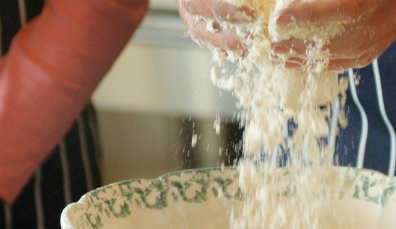

March 17 is time to celebrate Ireland’s contribution to the world. And when it comes to food, the island has created some famous dishes perfect for any St Patrick’s Day get-together.
Irish or not, the world goes green on St Patrick’s Day. But with such a range of delicious traditional foods to choose from, you don’t have to think emerald-colored when it comes to your St Patrick’s Day party menu. From beef and Guinness stew to smoked salmon pâté, we’ve got some wonderful suggestions from iconic food establishments all over the island.


Cliff Academy: Lesley Keogh’s Brown Irish soda bread
This traditional bread is baked in kitchens across Ireland every day, and couldn’t be easier to prepare. Remember to mark the distinctive cross in it before it goes in the oven: it’s to let the fairies out, apparently.
- 220g/8oz plain flour
- 220g/8oz wholemeal flour
- ½ tsp salt
- 1 tsp baking powder or bicarbonate of soda
- 1 pint/500ml buttermilk
- Preheat the oven to 180C/350F/Gas mark 4.
- Mix all the dry ingredients together in a bowl.
- Make a well in the centre and pour in the buttermilk, using your hands to draw the flour and milk together.
- Pour ingredients onto a floured surface and lightly form into a round (do not over-knead).
- Cut a cross on the top.
- Place onto a floured baking tray and put into the oven for about 35-40 minutes.
- When you take the bread out, turn it upside down and tap the bottom. If the bread sounds hollow it's done. Leave to cool on a wire rack.


Cliff Academy: Lesley Keogh’s Smoked salmon pâté
The west coast of Ireland is famous for its quality traditional smoked salmon. Beautiful served on its own, you can also give it a twist with this simple pâté recipe.
- 8oz/225g smoked salmon
- 8oz/225g cream cheese
- 1 tsp horseradish sauce
- 1 tsp lemon juice
- A few sprigs of dill
- Place all the ingredients in a food processor and blend until rich and creamy. It’s as simple as that!
- Then serve with a crisp green salad or some watercress for a shamrock-style effect. Don’t use shamrock – as pretty as it looks, it’s not actually edible. Watercress makes a good edible substitute.


Cashel House: Warm Cashel mussels with garlic, tomato and chilli
Mussels are one of the most abundant of all Irish shellfish and have been eaten here since ancient times. There are dishes devoted to them, and festivals dedicated to them. They’re even immortalised in the famous Dublin song, Molly Malone… As Molly wheels her wheelbarrow crying: cockles and mussels alive, alive-oh!
- 6.5 lb/3kg mussels
- 3 cloves of garlic, peeled and finely chopped
- 1 red chilli, finely chopped
- 1 tin of plum tomatoes (14oz/400g)
- ½ pint/300ml lager
- 2 scallions (spring onions), cut into strips
- Olive oil
Method
- Wash the mussels in cold water, scrub well and remove the beards. Use only mussels that are tightly closed, discarding any that are open.
- In a large pan, heat some olive oil and sauté the garlic to soften without browning.
- Add the mussels and cook for five minutes (or just until the shells are opening).
- Add the chopped chilli and tomatoes.
- Cook for a further three minutes to heat through, then finally add the lager and cook for a further two minutes or until the broth reaches boiling point.
- Serve in large bowls topped with sliced scallions and accompany with homemade brown soda bread.


Wineport Lodge: Beef and Guinness stew
This is a classic Irish dish that is perfect for feeding a group of people. With the distinctive flavour of Guinness, it makes a good alternative to Irish stew.
- 2.25 lb/1kg of stewing beef (shin, flank or rib), trimmed and cut into 1in/2.5 cm cubes
- 1oz/25g flour
- 1 onion, peeled and sliced
- 2 carrots, sliced thickly
- 1 large or 2 small parsnips, peeled and cubed
- 1 pint/600ml Guinness, or beef stock
- Quarter bottle/225ml prune juice or to taste (optional)
- Bouquet garni or mixed herbs
- Half celeriac or 3-4 stalks celery, trimmed and cubed
- Half an orange, left whole (optional)
Method
- Season the beef and toss in the flour to coat.
- Heat a little oil and butter in a heavy pan and brown the meat in batches, then transfer to a casserole dish.
- Add the onions and other vegetables, and sweat gently for a few minutes in the same pan.
- Transfer to the casserole dish.
- Add any remaining flour to the pan, stir to absorb whatever fat is left, then cook for a minute before stirring in the Guinness (or stock and prune juice if using).
- Add the liquids to the casserole (enough to cover the main ingredients) as well as the bouquet garni or mixed herbs and the orange.
- Season, stir to mix well, cover and cook in the oven for about 2 hours, or until the beef is tender.
- Remove the orange and bouquet garni, check seasoning, and add two prunes soaked in Guinness (optional).
- Serve with mashed potatoes and garnish with chopped parsley.


Roadside Tavern: Burren Smokehouse hot smoked salmon on a bed of colcannon
This is the signature dish of the Roadside Tavern in Lisdoonvarna, County Clare. It features “hot” smoked salmon, as well as colcannon, a traditional Irish dish of cabbage or kale and mashed potatoes.
- 28oz/800g Burren Smoked Organic Salmon, plain
For the colcannon:
- 1lb/500g floury potatoes
- 4 cups shredded leaves of cabbage
- 2 tbsp chopped scallions (spring onions)
- 2 tbsp butter or margarine
- 2fl oz/50ml heated milk
- Salt and black pepper, to taste
For the mustard cream sauce:
- 1 tbsp wholegrain mustard
- 1 pint/500ml cream
- 2 tbsp white wine
Method
For the colcannon:
- Boil the peeled potatoes in lightly salted water until tender, then drain.
- Boil the cabbage and onion for about five minutes. Drain and set aside.
- Mash the potatoes with the milk, butter, salt and pepper to taste.
- Add the spring onion and cabbage mixture.
For the mustard cream sauce:
- Mix all the ingredients together and heat gently until warm.
To assemble:
- Cut the Hot Smoked Organic Salmon into four pieces.
- Heat the salmon in a preheated oven for five minutes at 175°C or 350°F.
- To decorate the plate, start by placing the base of colcannon.
- Pour the mustard cream sauce over and top the dish with the Burren Hot Smoked Salmon. (Addition of stir-fried vegetables is optional)


Bushmills Inn: Armagh apple tartlets with caramel sauce
Armagh apples are a strong part of Irish food heritage, and have European PGI status, meaning they are specific to their geographical region. Not only that, but they’re delicious, too!
For the frangipane:
- 3oz/75g caster sugar
- 3oz/75g unsalted butter
- 1 large egg (beaten)
- 4oz/110g ground almonds
- 1oz/25g plain flour
- ½ fl oz/15ml milk
- A dash of Calvados, or brandy, if preferred
For the tartlet:
- 4 thin rounds puff pastry, approximately 6in/15cm in diameter
For the caramel sauce:
- 14oz/400g caster sugar
- 16fl oz/500ml cold water
- 16fl oz/500ml cream
- 3-4 eating apples
- 1oz/25g unsalted butter, melted
- A little icing sugar
For the garnish:
- A little crème fraîche and fresh mint leaves
- Preheat your oven to 180°C/350°F/Gas mark 4.
For the frangipane:
- Beat the butter and sugar until light and fluffy, then fold in the egg, ground almonds, flour, milk, and finally, the Calvados.
- Chill in the fridge until required.
For the tartlets:
- Place the puff pastry discs onto a floured baking tray and prick with a fork, then bake in the pre-heated oven for 8-10 minutes or until golden brown and slightly rising.
- While still warm, and to keep the disc quite flat, place another baking sheet on top and push down slightly to expel the air from the pastry.
For the caramel sauce:
- In a heavy-based pan, heat the sugar and water gently until it forms a rich golden syrup.
- Remove from the heat and allow to cool slightly, then heat the cream and carefully add to the syrup.
- Return to the heat for a few seconds.
- Strain through a fine sieve if necessary.
To assemble:
- Arrange the cooled pastry discs on a baking sheet and spread a layer of the frangipane on each one, leaving a narrow margin around the edge.
- Peel, core and thinly slice the apples and arrange neatly on top of the tarts.
- Brush with melted butter and bake for 10-12 minutes.
- Finally, dust the tart with icing sugar and place under the grill until the sugar starts to caramelise.
- Serve the tartlets on warmed dessert plates, with a drizzle of caramel sauce around them.
- Garnish with a little crème fraîche and a sprig of mint, and dust with the icing sugar.
And now… enjoy!
Now that you’re ready to tuck right in, it’s only fitting that you serve up your Irish feast with this Irish blessing:
May your pockets be heavy and your heart be light, May good luck pursue you each morning and night.
Irish Blessing

























